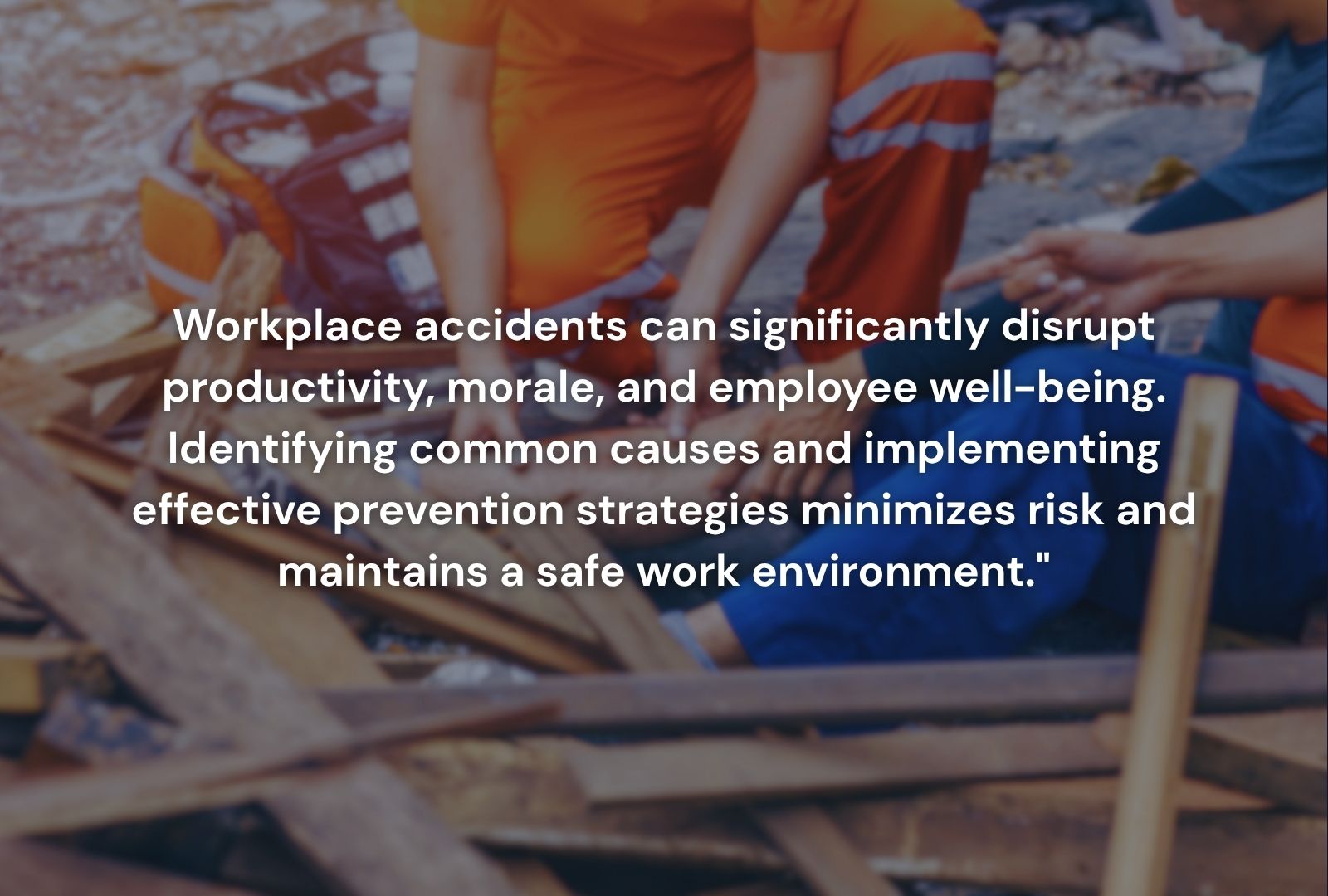Workplace accidents can significantly disrupt productivity, morale, and employee well-being. Identifying common causes and implementing effective prevention strategies minimizes risk and maintains a safe work environment.
If you've experienced a serious workplace accident, consulting a personal injury lawyer ensures your rights are protected and helps you receive appropriate compensation.

1. Slips, Trips, and Falls
Slips, trips, and falls cause approximately 25% of workplace injuries. Wet floors, cluttered walkways, and poor lighting contribute to these incidents.
- Prevention Strategies:
- Maintain clean, dry floors.
- Use signage to warn of hazards.
- Install adequate lighting in all work areas.
2. Overexertion and Muscle Strains
Overexertion, often from lifting or repetitive movements, accounts for nearly 35% of injuries involving missed workdays.
- Prevention Strategies:
- Provide proper training on lifting techniques.
- Encourage regular breaks and rotation of tasks.
- Implement ergonomic workstations and equipment.
3. Being Struck by Objects
Workers frequently suffer injuries from falling or flying objects, especially in construction and manufacturing sectors.
- Prevention Strategies:
- Require appropriate personal protective equipment (PPE), such as hard hats.
- Ensure secure storage of materials.
- Implement barriers around hazardous areas.
4. Vehicle-Related Accidents
Vehicle accidents, including forklifts and delivery trucks, cause severe workplace injuries and fatalities.
- Prevention Strategies:
- Provide extensive training for vehicle operation.
- Clearly mark vehicle paths and pedestrian walkways.
- Conduct regular vehicle maintenance and inspections.
5. Machinery Accidents
Accidents involving machinery often result from improper use or lack of maintenance.
- Prevention Strategies:
- Conduct regular equipment inspections and maintenance.
- Provide thorough training for machinery operation.
- Use safety guards and emergency stop mechanisms.
6. Fires and Explosions

Workplace fires and explosions typically result from faulty electrical equipment, improper chemical storage, or open flames.
- Prevention Strategies:
- Regularly inspect and maintain electrical equipment.
- Store hazardous materials according to OSHA standards.
- Ensure accessible fire extinguishers and conduct regular fire drills.
7. Chemical Exposure
Chemical exposure accidents occur due to spills, leaks, or inadequate handling procedures.
- Prevention Strategies:
- Train employees in proper handling and storage techniques.
- Provide appropriate PPE, including gloves, goggles, and respirators.
- Maintain clear labeling and safety data sheets for all chemicals.
8. Workplace Violence
Workplace violence incidents, including assaults or threats, pose risks to employee safety and morale.
- Prevention Strategies:
- Develop clear policies on workplace conduct.
- Train supervisors and employees to recognize warning signs.
- Implement secure entry and exit protocols.
9. Electrical Accidents
Electrical accidents typically involve exposed wiring, overloaded circuits, or faulty equipment.
- Prevention Strategies:
- Regularly inspect electrical systems and cords.
- Train employees on electrical safety best practices.
- Replace damaged equipment immediately.
10. Inadequate Safety Training
Insufficient training leads to employees being unaware of workplace hazards and proper safety procedures.
- Prevention Strategies:
- Provide comprehensive onboarding and ongoing safety training.
- Regularly review and update training materials.
- Foster a culture of safety awareness and accountability.
Exploring Related Safety Topics

Expanding your understanding of workplace safety includes examining related topics:
- Workers Compensation Laws: Learn about specific state regulations and compliance requirements that protect employee rights.
- Injury Reporting Procedures: Implementing clear and effective reporting protocols ensures prompt attention and minimizes complications following accidents.
- Workers Compensation Insurance: Understanding insurance obligations helps employers provide necessary coverage and support for injured workers.
Familiarity with these areas enhances workplace safety practices and employee protection.
Conclusion: Prioritize Prevention for Workplace Safety
Addressing the primary causes of workplace accidents through targeted prevention strategies creates safer environments, reduces injury rates, and promotes overall organizational health. Regular training, diligent maintenance, and clear safety protocols significantly mitigate workplace hazards, benefiting both employers and employees.



.avif)














